The Pocock Generation
The 3rd Generation Conibear Stroke
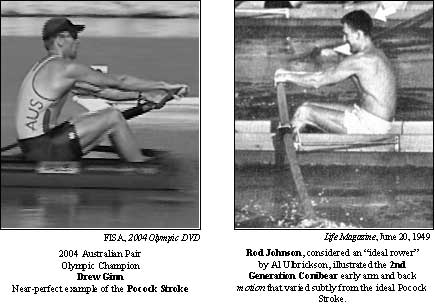
When five members of the 1948 University of Washington jayvee became the Husky entry in the coxed-four event at the 1948 Olympic Trials, they had the unique opportunity to be coached by both George Pocock and Al Ulbrickson.
Coxswain Allen Morgan: "Al and George were of the same school. The two of them were in synch.
"During the year, Al would have George come out during practices, and with fresh eyes, George could pick up things that Al couldn't see, having stared at his crews for so long." 1
Bob Martin, jayvee 7-man: "Washington crews always did their best when Al listened to George. He was able to pick out individuals who needed special attention.
"For instance, one day I came down to the boathouse to find that he had raised my seat ¾ of an inch. This was after rowing for 1½ years." 2
As he already had for nearly 40 years, George Pocock set the tone and raised the level of oarsmanship for the 1948 Husky crews. It seemed that he had always been the soul of Washington rowing.
Jayvee 5-man Gus Giovanelli: "It was tough for Al coaching back then because most of us were returning World War II veterans, and he had to be really careful what he said, or we would tell him to go to hell.
"Charlie McCarthy stroked the '48 and '49 varsities after two years in the 3rd boat. I remember during practices, he and Al would have a running 'conversation,' he complaining and Al telling him to shut up, both screaming, and both using a wide-ranging, colorful vocabulary.
"But when you couldn't talk to Al, you could talk to George. He played a huge team role." 3
Practicing at Lake Carnegie
After sweeping all three races at the IRA in 1948, a supremely confident Washington squad, the defending Olympic Champions from before the war in 1936, had headed straight to Princeton to prepare for the Olympic Trials.
Ulbrickson certainly recalled with bitterness the events of eight years earlier in 1940, when his varsity had been scheduled to race in the Olympic Trials for eights, and the stern four of the jayvee was slated to race in the Trials for coxed-fours.
"Four days before Poughkeepsie, they found out that the 1940 Olympics had been cancelled due to the war in Europe." 4
This came four years after the University of Washington Olympic triumph in Berlin, and "it was a tremendous disappointment. Both crews went on to win the 1940 IRA, and both certainly would have been favored at the Trials." 5
The first Olympics to be scheduled after World War II was London in 1948, and Ulbrickson again prepared to enter both the eight and the coxed-four Trials.
From his vantage point in the Cornell eight, Chuck von Wrangell remembers watching the Washington four practice at the Trials site on Lake Carnegie.
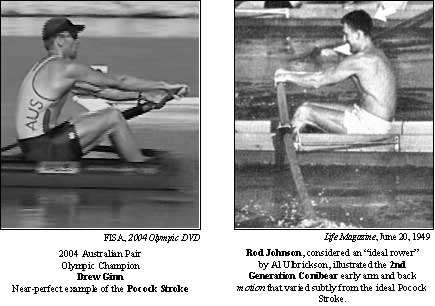
"Washington had brought along to Poughkeepsie a special four-oared shell named Clipper Too, built in 1936 as the sister to the Husky Clipper, which won the 1936 eights Gold Medal for them.
"As soon as all the teams arrived at Princeton for the Trials, the stern four from their IRA-Champion jayvee got into the boat and began rowing it for the first time.
"It was a sleek boat built by George Pocock, and on the day that I was watching, he appeared to coach them almost exclusively. Al Ulbrickson was wise enough to step back a bit and let George coach the four in the boat that he built.
"I remember at the moment they came by me, George was chewing them out for breaking their arms too early.
"Ulbrickson had coached his varsity and jayvee coxswains to call out, 'Stand and draw!' on practically every stroke. 'Stand,' of course, meant push those legs, and 'draw' meant pull with the arms, and like our Cornell crew, the Huskies were known for using their arms right from the catch.
"George wanted leg drive strong enough to hold those arms straight longer." 6
Martin and jayvee 6-man Bob Will have no memory of there being any difference between the approaches of Al Ulbrickson and George Pocock.
Martin: "Their whole concept of rowing was that there were no singular movements. Everything started and finished at the same time. There was none of the legs going down first. Neither taught us that. In fact, we called that 'shooting your slide!'" 7
Well, as Stan Pocock has so sagely said, "Herein arises the cause of some confusion.
"One of the admonitions heard from Ulbrickson was to 'hang yourself on the oar' at the catch, in other words, really throw your back into it as you drove the blade into the water with the legs. Here again, the idea was to have everything trying to move the oar at the same time, while physical reality made it appear as though the legs were driving first, followed by the back, with the arms chiming in last of all." 8
As was discussed earlier, even though both Ulbrickson and Pocock believed in the concurrent use of legs, back and arms, all working together starting at the catch, George's ideal stroke included a component not part of Ulbrickson's 2nd Generation Conibear Stroke, namely initial leg drive strong enough to initially immobilize the backs and arms.
This distinction between Ulbrickson's pure concurrent technique and Pocock's hybrid-concurrent technique with legs emphasized was subtle in the extreme, and Pocock was aware that even mentioning stronger leg drive ran the risk of losing the Schubschlag "one cut" feeling, encouraging slide shooting and/or a Kernschlag segmented pull-through, which George abhorred as much as Al.
The issue that George Pocock was addressing on the day that von Wrangell was listening in probably had a lot to do with the difficult transition from an eight to a four.
A four is inherently harder to set up than an eight. It would have been quite natural if the crew was initially a bit tentative in applying their legs as they were slowly getting used to their new event at Princeton.
Giovanelli: "Legs were always a strong point in Washington rowing. George emphasized drive with the legs even more with us because you have so much more weight to pick up in a four, and the legs are the most powerful muscles." 9
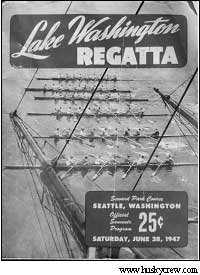
There was also the issue of the unorthodox rowing technique jayvee stroke-man Warren Westlund. Wes, a sophomore, had stroked the 1947 IRA-winning Washington freshman crew, and that crew had won varsity letters by beating the varsity and jayvee in a time trial for the right to row in the 2,000 meter Lake Washington Regatta, which was won by Harvard with Yale second and the Husky freshmen third.
Rod Johnson was 1947 freshman 7-man behind Wes. He was the 1948 varsity 7-man and fraternity brother of varsity stroke Charlie McCarthy, of Wes and Bob Will of the jayvees and of 1947-grad Stan Pocock.
Johnson enjoyed rowing behind Westlund. "Al would say that Wes was hunkering down all the time, but because of that he got a lot of reach, more than you could if you sat upright." 10
Giovanelli: "Wes had an old injury that prevented him from straightening his left arm all the way." 11 Perhaps as a consequence, Westlund's style appeared to be the antithesis of Johnson's ideal Ulbrickson stroke. Note the contrast in arms in the photograph of the two of them on this page, taken in September, 1948.
Wes stood out on the Washington squad like the proverbial sore thumb for precisely the issue that George was addressing with the four that afternoon in Princeton. His arms were definitely bent from the catch.
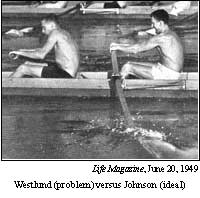 Bob Will: "We weren't the best-looking crew in the world. Wes also tended to wash out. Fortunately, there was nobody in front of him to get caught, but he was an easy man to row with. That's why he was a good stroke." 12
Bob Will: "We weren't the best-looking crew in the world. Wes also tended to wash out. Fortunately, there was nobody in front of him to get caught, but he was an easy man to row with. That's why he was a good stroke." 12
Any subtle distinctions between the rowing techniques of Ulbrickson and Pocock, however, did nothing to compromise their mutual trust and support, and indeed were irrelevant to the four as they transitioned to their new boat.
Von Wrangell: "Those four jayvees listened, and their legs came down hard after the catch, with the back swing and arm-squeeze later." 13
The Technique of the 1948 Washington Four
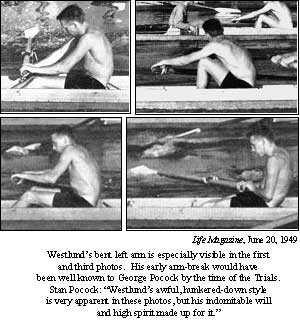 The Washington four was a very impressive and physical group for the period. Three of the four were returning World War II veterans.
The Washington four was a very impressive and physical group for the period. Three of the four were returning World War II veterans.
They averaged 22 years old and more than 6'4" in height. Endless miles of rowing had left them extremely fit and lean, averaging 185 lb.
Bob Will: "We weren't students of what we were doing. We just tried to do what we were told, but the long, smooth, everything-together, low-speed rowing was our forté.
"When we rowed 32, man that was high speed!
"All we did was row, because we didn't have to worry about ice in the winter. Back East they had to use tanks, and they rowed on machines. No weights, no ergometers back then.
"The only time we ever rowed 2,000 meters was for the Olympics, and so every Monday that's what we did. I remember because I hated it. It was a sprint but a damn long sprint, and we only did it when the Olympics were a year or two away." 14
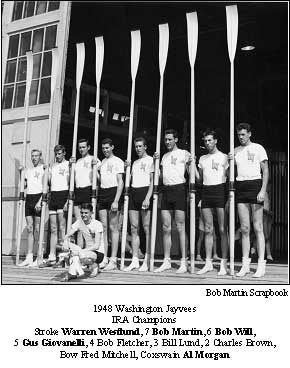 At the end of several weeks of work with George Pocock, the athletes sensed no change in their technique, but film of the crew discloses a subtle but significant evolution from the Ulbrickson standard.
At the end of several weeks of work with George Pocock, the athletes sensed no change in their technique, but film of the crew discloses a subtle but significant evolution from the Ulbrickson standard.
Early in the pullthrough the legs were pressed down more aggressively, even though leg motion still extended right to the end of the stroke. The back swung from the catch, and the last few degrees of layback were exchanged for a more pronounced ferryman's finish. The result was +5°, +30° to -15°, 0-10, 0-9, 0-10, in contrast to Ulbrickson's +5°, +30° to -25°, 0-10, 0-9, 0-10 characterized by steadier leg drive, more layback and less ferryman's finish.
This change was sufficiently significant to be considered the birth of a 3rd Generation of the Conibear Stroke, which might also be called the Pocock Generation of the Conibear Legacy.
The 1948 Season
At Princeton, the Washington eight and four seldom worked out together, partly because they did not particularly get along.
Bob Martin remembers: "Our eventual four had started out as the stern four of the varsity, but one day in late April or early May, Ulbrickson had the boats pulled together out on the water and switched all five of us, including Al, our coxswain, into the jayvee.
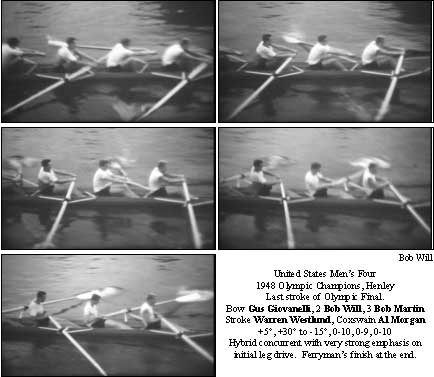
"We were naturally very disappointed, but what was worse, the new varsity immediately looked down their noses at us.
"As a consequence, there was quite a rivalry between the boats." 15
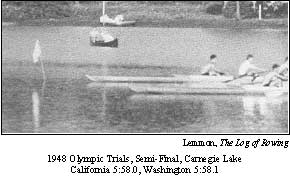 At some point on the trip to Poughkeepsie, there was a race between the jayvee and varsity, but the details seem lost now in the mists of time. Varsity 7-man Rod Johnson has no recollection of the race at all. Gus Giovanelli remembers it happening in Madison, Wisconsin. "We took the lead at the start, but eventually the other boat started creeping back. The second they had edged past us, Al stopped the race early because Al had gotten the result he was looking for." 16
At some point on the trip to Poughkeepsie, there was a race between the jayvee and varsity, but the details seem lost now in the mists of time. Varsity 7-man Rod Johnson has no recollection of the race at all. Gus Giovanelli remembers it happening in Madison, Wisconsin. "We took the lead at the start, but eventually the other boat started creeping back. The second they had edged past us, Al stopped the race early because Al had gotten the result he was looking for." 16
Bob Martin has a quite different recollection: "I'm pretty certain the last time trial was in Poughkeepsie. We started even, and when we started to pull ahead, Al stopped us, and that was the crowning blow.
"We really thought that Al might switch the boats, and that we'd become the varsity if we won. It had been done before, but he didn't do it. He didn't let us finish the race." 17
- Morgan, personal conversation, 2005
- Martin, personal conversation, 2005
- Giovanelli, personal conversation, 2005
- www.huskycrews.com
- www.huskycrews.com
- von Wrangell, personal correspondence, 2005
- Martin, personal correspondence, 2005
- S. Pocock, personal correspondence, 2005
- Martin, personal conversation, 2005
- Johnson, personal conversation, 2005
- Giovanelli, personal conversation, 2005
- Will, personal conversation, 2005
- von Wrangell, personal correspondence, 2005
- Will, personal conversation, 2005
- Martin, personal conversation, 2005
- Giovanelli, personal conversation, 2005
- Martin, personal conversation, 2005
If you enjoy and rely on row2k, we need your help to be able to keep doing all this. Though row2k sometimes looks like a big, outside-funded operation, it mainly runs on enthusiasm and grit. Help us keep it coming, thank you! Learn more.
- Bont Rowing
- Calm Waters Rowing
- Concept 2
- Craftsbury Sculling
- The Crew Classic
- CrewLAB
- Croker
- Durham Boat Co.
- Empacher
- Faster Masters
- Filippi
- Fluidesign
- h2row.net
- HUDSON
- Live2Row Studios
- Nielsen-Kellerman
- Oak Ridge RA
- Peinert Boat Works
- Pocock Racing Shells
- Race1 USA
- RowKraft
- Rubini Jewelers
- Vespoli USA
- WinTech Racing
- Bont Rowing
- Calm Waters Rowing
- Concept 2
- Craftsbury Sculling
- The Crew Classic
- CrewLAB
- Croker
- Durham Boat Co.
- Empacher
- Faster Masters
- Filippi
- Fluidesign
- h2row.net
- HUDSON
- Live2Row Studios
- Nielsen-Kellerman
- Oak Ridge RA
- Peinert Boat Works
- Pocock Racing Shells
- Race1 USA
- RowKraft
- Rubini Jewelers
- Vespoli USA
- WinTech Racing
















